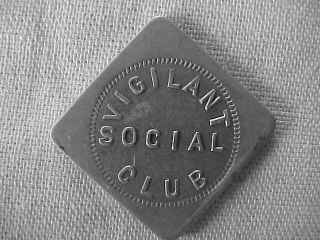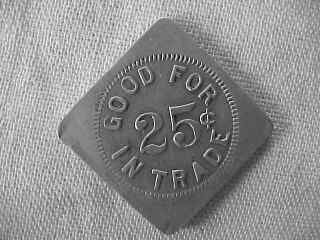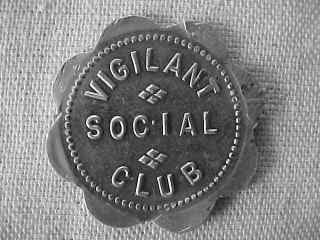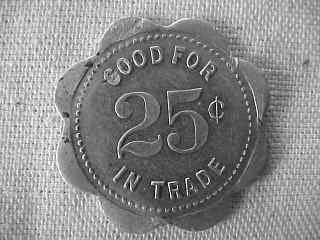

PAGE 14

by Jerry Adams, copyright © 1998, all rights reserved
VIGILANT / SOCIAL / CLUB
GOOD FOR / 5¢ / IN TRADE
alum -oct - 25mm


VIGILANT / SOCIAL / CLUB
GOOD FOR / 25¢ / IN TRADE
alum-square-25mm (yes, both the square and scalloped tokens are 25¢ denomination)


VIGILANT / SOCIAL / CLUB
GOOD FOR / 25 ¢ / IN TRADE
alum-scalloped (8 lobes)-29mm (estimated value : $6 each)


All three of these tokens were acquired in North Central Texas, and from the style of diework, I suspect they date from the 1900 to 1920 period. I have no idea as to their origin, or use. However the word "vigilant" in the name of the social club, has it’s roots in the vigilance committees of the old west.
Vigilantes and vigilance committees were commonplace across the West from the 1850’s until at least the 1940’s. Many sections of Texas, Oklahoma, New Mexico, Arizona and other parts of the frontier had few courts and judges, and juries would often not be depended on for justice. The solution to this problem seemed to be vigilantism. Vigilance committees were in fact organized, and were usually made up of law abiding responsible citizens whose only desire was the safety of their families. They were committed to law and order and to protect the lives and liberty of their neighbors. The outlaws they punished included horse thieves, murderers, cattle rustlers and train robbers.
Very few records exist to testify of the vigilance committees, as most were very secretive, and their operations were conducted at night. Some newspaper accounts survive to prove that they did function as an arm of frontier justice.
In the spring of 1857, seven horse thieves were hanged by vigilantes at various locations along the San Antonio River. Each body had the outer clothing and gunbelts placed beneath the hanging tree. On April 26, 1869, a horse thief was spirited out of the Richmond, Texas jail by vigilantes, and hanged by the neck from the beams of a new iron bridge across the Brazos River.
In Denison, Texas, after the Katy (Missouri , Kansas and Texas) Railroad arrived, vigilantes culled a group of outlaws and hung a horse thief on the night of January 12, 1874.
One of the largest vigilance committees, and certainly the best known in Texas was the one at Fort Griffin. Having caught a horse thief red handed on the night of April 9, 1876, they immediately hung the fellow from a large pecan tree. Since they left the body swinging in the breeze as a warning to other potential thieves, they also left a spade and pick below the body for the convenience of anyone who tired of the gruesome spectacle. In the following two months, the same vigilance committee shot two more horse thieves and hanged six others. Not yet content, in 1878 they executed a former sheriff of Shackelford County, who had turned to thievery, but this execution was by firing squad.
reference: Fort Griffin on the Texas Frontier, by Carl Coke Rister (Distinguished Professor of History at Texas Tech University)
on to page 15 of our token web pages...
updated 5 feb 2000